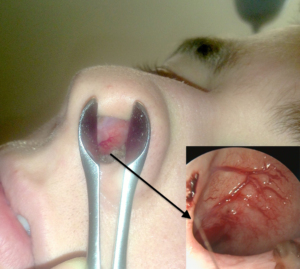Nosebleeds
Epistaxis or Nosebleed, meaning blood running from the nose, is a common problem, which happens in all age groups

In most cases, nosebleeds are caused by swollen (varicose) veins at the anterior part of the nasal septum (image). At an office setting, under topical anaesthesia, the bleeding vessels are cauterized with microwave technology (radiofrequency), and the problem is solved in a few minutes, with minimal discomfort.
However, there are cases, where the responsible vessel is not visible on examination, or there is a major cause for the bleed. In such case, the doctor may need to pack the nose and/or ligate a major vessel under endoscopic control, under general anaesthesia.
What to do to stop a nosebleed
As most bleeds come from the anterior part of the septum, you should press on the anterior nose. The correct procedure is as follows:
- Blow your nose to clear clots.
- Bend forward.
- Using two or three fingers, press firmly on the anterior (soft) part of the nose, until the bleeding stops.
- Keep firm pressure for five minutes (use your watch to keep time)
- Release pressure, keeping the head forward.
- If the bleeding continues, place on the nose a small plastic bag with 3-4 ice cubes, and seek medical help immediately.

Do not insert any material, such as cotton wool, gauze or paper, in the nose. You may cause trauma or leave a foreign body in the nasal cavity, which will cause severe infection.